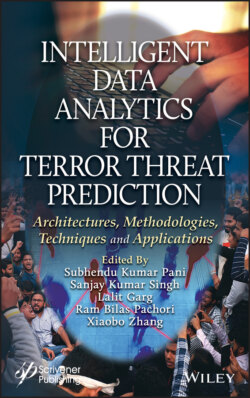Читать книгу Intelligent Data Analytics for Terror Threat Prediction - Группа авторов - Страница 25
1.4.1.1 Naïve Bayes Classifier
ОглавлениеIn machine learning, Naïve Bayes classification algorithm is a very simple algorithm which is based on a combination of Bayes theorem and naïve assumption. A Naïve Bayes classifier assumes that presence of one feature is unrelated to the other features presented in same class [30]. Generally the assuptions made by Naïve Bayes are not correct in real situations, and even independence assumption never correct, but it works well in practice [29].
Table 1.2 Dataset features [31].
| User features in social networks | Tweet features in Twitter | Comments features in social networks |
| No of followers | No of records | No of replies |
| No of friends | No of words | No of words |
| User has location in his profile | No of characters | No of characters |
| User has URL? | Tweet contains URL? | Comments contain URL? |
| User is a verified user? | Source of tweet | Source of comment |
| Ratio of friends/followers | Length of tweet | Length of tweet |
| Age of the user account | No of hash tags | No of question mark |
| Ratio of statuses/followers | No of mentions | No of pronouns |
| No of pronouns | No of URLs | |
| No of URLs | No of exclamation mark | |
| No of question mark | Polarity | |
| No of exclamation mark | Presence of colon symbol | |
| Polarity | ||
| Presence of colon symbol |
It can be done using the following Bayes theorem,
(1.1)
Where
P(c/x) is the posterior probability of class.
P(c) is the prior probability of class.
P(x/c) is the likelihood which is the probability of given class.
P(x) is the prior probability of predictor.
Naive Bayes classifier is a combination of Bayes theorem and Naïve assumptions. This algorithm calculates assumption values even though use multiple parameters as input. Rumor detection is purely based on either classification of text or images. For example, try rumor detection in social networks like Twitter or Facebook, then it is required to consider several features like User features, Tweet features, and Comment features. All these features deal with text data [32]. If Tweet or post or comment includes these features then one can apply Naïve Bayes classifier algorithm to classify them whether it is a rumor or not. These features are classified into three categories. Some of dataset features are listed in Table 1.2.
First, consider user features, number of followers or friends to a particular person are more, then it may be considered as truth, otherwise it is a rumor. Because, in survey it is observed that many people who share rumors may have less number of followers or friends in their social networking accounts. Second, there are many features to be considered as Tweet features from which one can detect whether it is rumor or not. For example, consider number of retweets, number of words or number of characters. If count of any one of these or all of these are more than average range in size, then the tweet may be rumor, otherwise it is truth. Third one is comment features. These are very much important features used in rumor detection. This feature is based on comments given by many people who are already infected by the particular post or tweet. If found comments like Is it real? Impossible? How it is possible? Or I can’t believe this, then the particular post/tweet may be a rumor. There have many other features to distinguish whether a post/tweet is rumor or not. Figure 1.4 below gives a brief idea about how Naïve Bayes algorithm classifies different classes of data points.
Figure 1.4 Naïve Bayes classifier.
It can be observed that there are two classes of data points and how they are classified with maximum distance.
Two classes are
1 i. Circle
2 ii. Triangle.
Adding more parameters in input dataset reduces the accuracy when compared to using less parameter. To increase the accuracy use another popular model SVM.
